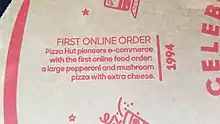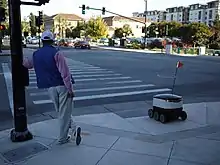Online food ordering
Online food ordering is the process of ordering food from a website or other application. The product can be either ready-to-eat food (e.g., direct from a home-kitchen, restaurant, or a ghost kitchen) or food that has not been specially prepared for direction consumption (e.g., vegetables direct from a farm/garden, frozen meats. etc).
| series on |
| E-commerce |
|---|
| Online goods and services |
| Retail services |
| Marketplace services |
| Mobile commerce |
| Customer service |
| E-procurement |
| Purchase-to-pay |
History in the US
The first online food order was a pizza from Pizza Hut in 1994.[1][2]

The online food ordering market has increased in the U.S with 40 percent of U.S adults having ordered their food online once.[3] The online food ordering market includes foods prepared by restaurants, prepared by independent people, and groceries being ordered online and then picked up or delivered.[4][5][6]
The first online food ordering service, World Wide Waiter (now known as Waiter.com), was founded in 1995.[7] The site originally serviced only northern California, later expanding to several additional cities in the United States.[8]
By the late 2000s, major pizza chains had created their own mobile applications and started doing 20–30 percent of their business online.[9] With increased smartphone penetration, and the growth of both Uber and the sharing economy, food delivery startups started to receive more attention. In 2010, Snapfinger, who is a multi-restaurant ordering website, had a growth in their mobile food orders by 17 percent in one year.[3]
By 2015, online ordering began overtaking phone ordering.[10]
In 2015, China's online food ordering and delivery market grew from 0.15 billion yuan to 44.25 billion yuan.[11]
As of September 2016, online delivery accounted for about 3 percent of the 61 billion U.S. restaurant transactions.[12]
Service types

Restaurant-controlled
In restaurant-controlled online food ordering, the restaurants create their own website and app, or choose to hire a delivery vendor. If they choose to create their own website, they make sure to obtain software that manages the orders efficiently, meaning it has the capability to manage different orders at once.[3] When they hire a vendor, the restaurant pays for a monthly fee or percentage-based fees. The vendor covers the developmental costs.[3]
A customer can choose to have the food delivered or for pick-up.[3] The process consists of a customer choosing the restaurant of their choice, scanning the menu items, choosing an item, and finally choosing for pick-up or delivery.[11] Payment is then administered by paying with a credit card or debit card through the app or website or in cash at the restaurant when going to pickup.[3] The website and app inform the customer of the food quality, duration of food preparation, and when the food is ready for pick-up or the amount of time it will take for delivery.[11] Papa John's is one of the restaurants that created their own Papa John's system, website, and app, and do their own delivery.[13] In 2010, they redesigned their website and launched mobile apps for iPhones, iPads, iPods, Androids Phones, Blackberrys, and Windows Phones.[14]
The preexisting delivery infrastructure of these franchises paired with the online ordering system. In 2010, Papa John's International announced that its online sales had exceeded $2 billion.[13]
Independent
In this case, a person cooks and offers meals or kits via their website, which are then directly sent to consumers.[4] The consumer chooses which meal and how many meals they want sent to their office or home, and pays depending on the meals or the program they are interested in. People choose to order meals from other people for different reasons: not wanting or having time to cook, wanting to eat home-cooked meals, or to lose weight by eating healthy foods. Examples of this type of service include DineWise, NutriSystem, Chef's Diet, etc.[4]
Food cooperatives
Some food cooperatives like Macomb Co-op[15] allow members to place orders of locally grown and/or produced food online and pick up and pay for their orders at a central location.[16]
Food riders and drivers
The riders and drivers for nearly all independent restaurant delivery app services are independent contractors, having the flexibility to choose when they work.[17] In Australia, specifically riders for the food app of Foodora, consider themselves employees because they sometimes work full time hours, are required to wear uniforms, and do set shifts.[17]
However, food delivery riders and drivers usually do not receive any insurance coverage, protective gear, or sick pay as independent contractors,[18] which have led to some asking for improved safety standards.[19] In response, Deliveroo gave riders a helmet with a GoPro camera to record any problems they may face, specifically with criminals. The riders have the opportunity to raise safety concerns about delivery areas in the app.[18]
See also
References
- "Pizza Hut Tells Twitter It Made The First Online Sale In 1994". Huffingtonpost.com. 2013-09-09. Retrieved 2018-08-14.
- "Hobbes' Internet Timeline 25". Zakon.org. Retrieved 2018-08-14.
- Kimes, Sheryl; Laque, Philipp (March 2011). "Online, Mobile, and Text Food Ordering in the U.S Restaurant Industry". Cornell Hospitality Report. Cornell University. 11.
- Leavell, Anne (October 2008). "Meal Delivery Weight-Loss Programs". Obesity Management. 4 (5): 250–256. doi:10.1089/obe.2008.0230.
- Scott, Jason (April 2018). "Instacart launching delivery service in Lancaster County next week". Central Penn Business Journal.
- "Grocers expand delivery, click-and-collect services". The Food Institute Report. 90 (30). July 2017.
- "How to Make Lunch an Adventure". partners.nytimes.com. Retrieved 2017-09-20.
- "Restaurant Review: Dosas and samosas". Paloaltoonline.com. Retrieved 2017-09-18.
- "Why Pizza Giants Want Customers to Click, Not Call, for Delivery". Adage.com. 2009-04-20. Retrieved January 10, 2016.
- "Online food delivery ordering is about to overtake phone ordering in the US – Quartz". Qz.com. Retrieved January 10, 2016.
- He, Zhou; Han, Guanghua; Cheng, T.C.E; Fan, Bo; Dong, Jichang (May 2018). "Evolutionary food quality and location strategies for restaurants in competitive online-to-offline food ordering and delivery markets: An agent-based approach". International Journal of Production Economic. 30: 61–72. doi:10.1016/j.ijpe.2018.05.008.
- "Restaurant food delivery heating up". Columbian.com. Retrieved January 10, 2016.
- "Online Ordering Leader Papa John's First to Surpass $2 Billion in Online Sales". Business Wire, Inc. May 2010.
- "Archived copy". Archived from the original on 2019-04-20. Retrieved 2019-04-18.CS1 maint: archived copy as title (link)
- "About". Macomb Food Co-op. Retrieved 2020-04-04.
- Kauffman, Jonathan (March 31, 2017). "The rise of the modern food cooperative". SFGate.com. San Francisco, CA.
- Zhou, Naaman (November 2018). "Foodora Australia admits riders owed $5m were "more likely than not" employees; Collapsed food delivery company has offered $3m to cover all creditors, but unions are demanding workers be paid out in full". Guardian Newspapers.
- O'Mahony, Daniel (August 2017). "Deliveroo introduces helmet cams in bid to protect riders". The London Evening Standard.
- Patty, Anna (January 2018). "Minimum pay and safety call for food riders". Fairfax Media Publications Pty.